A Study of the Low-Ozone Episode over Scandinavia and Northwestern Russia in March 2025
Abstract
1. Introduction
2. Methods, Data and Model Experiments
2.1. Dynamical Processes of Stratosphere
2.2. Total Column Ozone Satellite Observations and Ground-Based Measurement Data
2.2.1. DOAS Measurements
2.2.2. M-124 Filter Ozonometers
2.3. Chemistry-Transport Model Experiments
2.4. Surface UV Radiation
3. Results
3.1. Temperature of Polar Stratosphere
3.2. Ozone Layer
3.3. Ground-Based Total Column Ozone Measurements
M-124 Filter Ozonometer Observations
3.4. Modeling Results
3.5. Surface UV Radiation Analysis
4. Discussion and Conclusions
- -
- In comparison with the other winters, the stratospheric polar vortex in December 2024–February 2025 was very cold and persistent. The very low temperatures inside the stratospheric polar vortex in February 2025 led to the formation of PSC type I (NAT) with monthly mean volume exceeding the corresponding values of all winters with strong ozone loss, including February 2020. The lowest temperatures of the Arctic low stratosphere in early February allowed PSC type II (ICE) to form over several days, with values exceeding the records over all the years of observation. This type of PSC is the rarest in the Arctic; see [57].
- -
- The minor SSW in late February and the major SSW events in early March prevented the possible strong ozone depletion in the spring of 2025, which very likely could exceed the levels of spring 2020 with the record ozone loss observed in the Arctic over the whole period of observation.
- -
- The low-ozone episode over Scandinavia and northwestern Russia in early March 2025 was characterized by the record-breaking values of total ozone of 221 DU over St. Petersburg and very low values for Helsinki and Moscow, according to the OMI (204 DU and 242 DU, respectively).
- -
- Low total column ozone values in early March 2025 were confirmed using a ground-based M-124 ozonometer, DOAS measurements in St. Petersburg and a M-124 ozonometer in Moscow, as well as ERA5 reanalysis data. The largest daily negative deviations of M-124 ozonometer TCO measurements from the climate mean values for St. Petersburg and Moscow in early March 2025 reached about 40%.
- -
- The decrease in TCO values due to tropopause elevation and transport of low-ozone air masses along the anticyclone western periphery, as well as chemical ozone loss in the polar lower stratosphere, were the main processes responsible for the ozone mini-hole formation.
- -
- Chemistry-transport model experiments showed that dynamical processes played a predominant role in the low TCO values for St. Petersburg, Moscow and Helsinki in the late winter of 2025, but the role of chemical processes is not negligible.
- -
- Despite the reduced TCO values in early March 2025, the increase in UV radiation over Moscow, St. Petersburg and Helsinki reached up to 60–100%, and the absolute values remained safe, mainly due to the low solar zenith angle.
Author Contributions
Funding
Institutional Review Board Statement
Informed Consent Statement
Data Availability Statement
Acknowledgments
Conflicts of Interest
Abbreviations
| OMH | Ozone mini-hole |
| TCO | Total column ozone |
| PSC | Polar stratospheric cloud |
| CTM | Chemistry-transport model |
| SSW | Sudden stratospheric warming |
| UVI | Ultraviolet solar radiation index |
| UVR | Ultraviolet solar radiation |
| DOAS | Differential optical absorption spectroscopy |
Appendix A
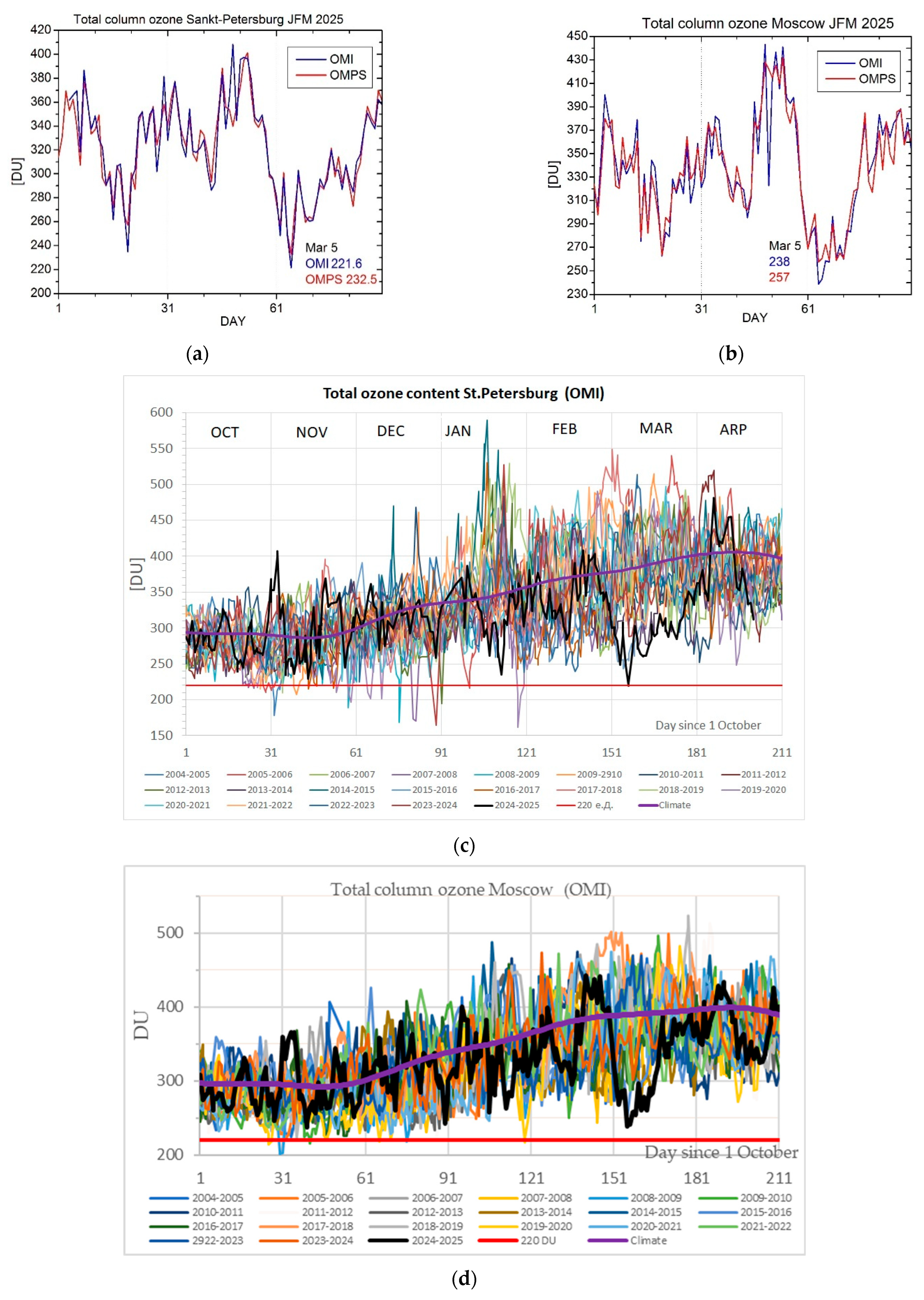

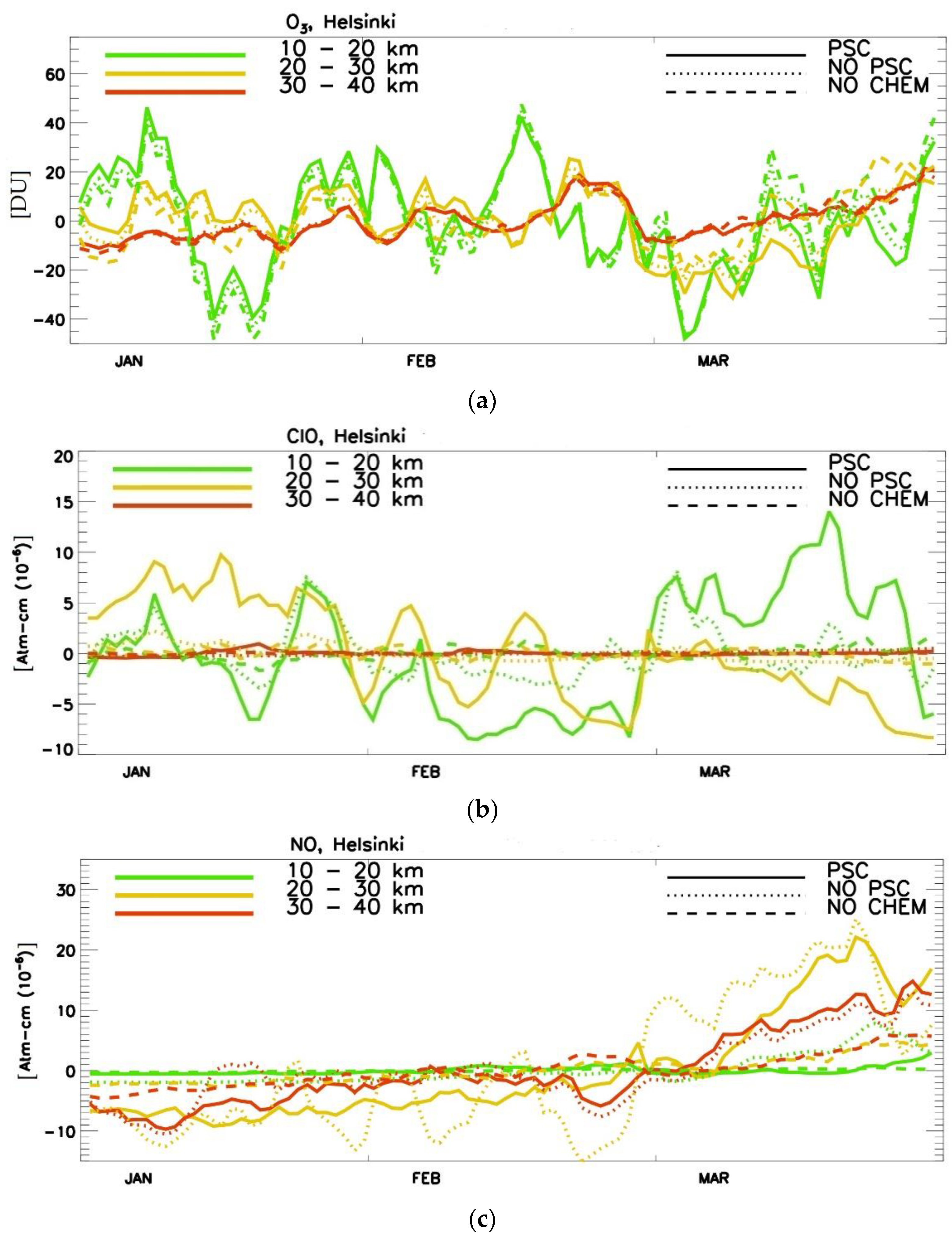
References
- World Meteorological Organization (WMO). Scientific Assessment of Ozone Depletion: 2022, GAW Report 278; WMO: Geneva, Switzerland, 2022; p. 509. [Google Scholar]
- Baldwin, M.; Birner, T.; Brasseur, G.; Burrows, J.; Butchart, N.; Garcia, R.; Geller, M.; Gray, L.; Hamilton, K.; Harnik, N.; et al. 100 Years of Progress in Understanding the Stratosphere and Mesosphere. Meteorol. Monogr. 2019, 59, 27.1–27.61. [Google Scholar] [CrossRef]
- Lawrence, Z.D.; Perlwitz, J.; Butler, A.H.; Manney, G.L.; Newman, P.A.; Lee, S.H.; Nash, E.R. The remarkably strong Arctic stratospheric polar vortex of winter 2020: Links to record-breaking Arctic Oscillation and ozone loss. J. Geophys. Res. Atmos. 2020, 125, e2020JD033271. [Google Scholar] [CrossRef]
- Manney, G.L.; Livesey, N.J.; Santee, M.L.; Froidevaux, L.; Lambert, A.; Lawrence, Z.D.; Millán, L.F.; Neu, J.L.; Read, W.G.; Schwartz, M.J.; et al. Record-Low Arctic Stratospheric Ozone in 2020: MLS Observations of Chemical Processes and Comparisons with Previous Extreme Winters. Geophys. Res. Lett. 2020, 47, e2020GL089063. [Google Scholar] [CrossRef]
- Smyshlyaev, S.P.; Vargin, P.N.; Motsakov, M.A. Numerical modeling of ozone loss in the exceptional Arctic stratosphere winter spring of 2020. Atmosphere 2021, 12, 1470. [Google Scholar] [CrossRef]
- Petkov, B.H.; Vitale, V.; Di Carlo, P.; Drofa, O.; Mastrangelo, D.; Smedley, A.R.; Diémoz, H.; Siani, A.M.; Fountoulakis, I.; Webb, A.R.; et al. An unprecedented Arctic ozone depletion event during spring 2020 and its impacts across Europe. J. Geophys. Res. Atmos. 2023, 128, e2022JD037581. [Google Scholar] [CrossRef]
- Wohltmann, I.; von der Gathen, P.; Lehmann, R.; Maturilli, M.; Deckelmann, H.; Manney, G.L.; Davies, J.; Tarasick, D.; Jepsen, N.; Kivi, R.; et al. Near-complete local reduction of Arctic stratospheric ozone by severe chemical loss in spring 2020. Geophys. Res. Lett. 2020, 47, e2020GL089547. [Google Scholar] [CrossRef]
- Bernhard, G.H.; Fioletov, V.E.; Grooß, J.U.; Ialongo, I.; Johnsen, B.; Lakkala, K.; Manney, G.L.; Müller, R.; Svendby, T. Record Breaking Increases in Arctic Solar Ultraviolet Radiation Caused by Exceptionally Large Ozone Depletion in 2020. Geophys. Res. Lett. 2020, 47, e2020GL090844. [Google Scholar] [CrossRef] [PubMed]
- Czerwińska, A.E.; Krzyścin, J.W. Climatological aspects of the increase of the skin cancer (melanoma) incidence rate in Europe. Int. J. Climatol. 2019, 40, 3196–3207. [Google Scholar] [CrossRef]
- Manney, G.L.; Santee, M.L.; Rex, M.; Livesey, N.J.; Pitts, M.C.; Veefkind, P.; Nash, E.R.; Wohltmann, I.; Lehmann, R.; Froidevaux, L.; et al. Unprecedented Arctic ozone loss in 2011. Nature 2011, 478, 469–475. [Google Scholar] [CrossRef] [PubMed]
- Karpechko, A.Y.; Backman, L.; Thölix, L.; Ialongo, I.; Andersson, M.; Fioletov, V.; Heikkilä, A.; Johnsen, B.; Koskela, T.; Kyrölä, E.; et al. The link between springtime total ozone and summer UV radiation in Northern Hemisphere extratropics. J. Geophys. Res. 2013, 118, 8649–8661. [Google Scholar] [CrossRef]
- von Gathen, P.; Kivi, R.; Wohltmann, I.; Salawitch, R.; Rex, M. Climate change favours large seasonal loss of Arctic ozone. Nat. Commun. 2021, 12, 3886. [Google Scholar] [CrossRef]
- Vargin, P.N.; Kostrykin, S.V.; Volodin, E.M.; Pogoreltsev, A.I.; Wei, K. Arctic stratosphere circulation changes in XXI century in simulations of INM CM5. Atmosphere 2022, 13, 25. [Google Scholar] [CrossRef]
- Vargin, P.; Kostrykin, S.; Koval, A.; Rozanov, E.; Egorova, T.; Smyshlyaev, S.; Tsvetkova, N. Arctic stratosphere changes in the 21st century in the Earth system model SOCOLv4. Front. Earth Sci. 2023, 11, 1214418. [Google Scholar] [CrossRef]
- Peters, D.; Egger, J.; Entzian, G. Dynamical aspects of ozone mini-hole formation. Meteorol. Atmos. Phys. 1995, 55, 205–214. [Google Scholar] [CrossRef]
- James, P.M. A Climatology of ozone mini-holes over the Northern Hemisphere. Int. J. Climatol. 1998, 18, 1287–1303. [Google Scholar] [CrossRef]
- Sitnov, S.A.; Mokhov, I.I. Satellite-derived peculiarities of total ozone field under atmospheric blocking conditions over the European part of Russia in summer 2010. Russ. Meteorol. Hydrol. 2016, 41, 28–36. [Google Scholar] [CrossRef]
- Schneidereit, A.; Schubert, S.; Vargin, P.; Lunkeit, F.; Zhu, X.; Peters, D.; Fraedrich, K. Large scale flow and the long-lasting blocking high over Russia: Summer 2010. Mon. Weather Rev. 2012, 140, 2967–2981. [Google Scholar] [CrossRef]
- Shaposhnikov, D.; Revich, B.; Bellander, T.; Bedada, G.B.; Bottai, M.; Kharkova, T.; Kvasha, E.; Lind, T.; Pershagen, G. Long-Term Impact of Moscow Heat Wave and Wildfires on Mortality. Epidemiology 2015, 26, e21–e22. [Google Scholar] [CrossRef]
- Orsolini, Y.J.; Nikulin, G. A low-ozone episode during the European heatwave of August 2003. Q. J. R. Meteorol. Soc. 2006, 132, 667–680. [Google Scholar] [CrossRef]
- Sofiev, M.; Kouznetsov, R.; Hänninen, R.; Sofieva, V.F. Technical note: Intermittent reduction of the stratospheric ozone over northern Europe caused by a storm in the Atlantic Ocean. Atmos. Chem. Phys. 2020, 20, 1839–1847. [Google Scholar] [CrossRef]
- Sitnov, S.A.; Mokhov, I.I. Relationship of the ozone mini-hole over Siberia in January 2016 to atmospheric blocking. Dokl. Earth Sci. 2021, 500, 772–776. [Google Scholar] [CrossRef]
- Nikiforova, M.P.; Vargin, P.N.; Zvyagintsev, A.M. Ozone Anomalies over Russia in the Winter-Spring of 2015/2016. Russ. Meteorol. Hydrol. 2019, 44, 23–32. [Google Scholar] [CrossRef]
- Timofeyev, Y.M.; Smyshlyaev, S.P.; Virolainen, Y.A.; Garkusha, A.S.; Polyakov, A.V.; Motsakov, M.A.; Kirner, O. Case study of ozone anomalies over northern Russia in the 2015/2016 winter: Measurements and numerical modelling. Ann. Geophys. 2018, 36, 1495–1505. [Google Scholar] [CrossRef]
- Chubarova, N.E.; Timofeev, Y.M.; Virolainen, Y.A.; Polyakov, A.V. Estimates of UV indices during the periods of reduced ozone content over Siberia in winter-spring 2016. Atmos. Ocean. Opt. 2019, 32, 177–179. [Google Scholar] [CrossRef]
- Vargin, P.N.; Fomin, B.A.; Semenov, V.A. Influence of ozone mini-holes over Russian territories in May 2021 and March 2022 revealed in satellite observations and simulation. Atmos. Ocean. Opt. 2023, 36, 578–589. [Google Scholar] [CrossRef]
- Schwarz, M.; Baumgartner, D.J.; Pietsch, H.; Blumthaler, M.; Weihs, P.; Rieder, H.E. Influence of low ozone episodes on erythemal UV-B radiation in Austria. Theor. Appl. Climatol. 2018, 133, 319–329. [Google Scholar] [CrossRef]
- Laschewski, G.; Matzarakis, A. Long-Term Changes of Positive Anomalies of Erythema-Effective UV Irradiance Associated with Low Ozone Events in Germany 1983–2019. Environments 2023, 10, 31. [Google Scholar] [CrossRef]
- Jhappan, C.; Noonan, F.; Merlino, G. Ultraviolet radiation and cutaneous malignant melanoma. Oncogene 2003, 22, 3099–3112. [Google Scholar] [CrossRef]
- Herzen Moscow Research Institute of Oncology. Malignant Neoplasms in Russia in 2023 (Morbidity and Mortality); Kaprin, A.D., Starinsky, V.V., Shakhzadova, A.O., Eds.; Herzen Moscow Research Institute of Oncology: Moscow, Russia, 2024; ISBN 978-5-85502-298-8. Available online: https://oncology-association.ru (accessed on 31 July 2025). (In Russian)
- Pinault, L.; Fioletov, V. Sun Exposure, Sun Protection and Sunburn Among Canadian Adults; Catalogue No. 82-003-X. Health Reports; Statistics Canada: Ottawa, ON, Canada, 2017; Volume 28, pp. 12–19. [Google Scholar] [PubMed]
- Mokhov, I.I.; Timazhev, A.V. Atmospheric blocking and changes in its frequency in the 21st century simulated with the ensemble of climate models. Russ. Meteorol. Hydrol. 2019, 44, 369–377. [Google Scholar] [CrossRef]
- Barriopedro, D.; Anto, M.; Garcia, J.A. Atmospheric blocking signatures in total ozone and ozone miniholes. J. Clim. 2010, 23, 3967–3983. [Google Scholar] [CrossRef]
- Crespo-Miguel, R.; Ordóñez, C.; García-Herrera, R.; Schnell, J.; Turnock, S. Large-scale ozone episodes in Europe: Decreasing sizes in the last decades but diverging changes in the future. Sci. Total Environ. 2024, 949, 175071. [Google Scholar] [CrossRef]
- Kalnay, E.; Kanamitsu, M.; Kistler, R.; Collins, W.; Deaven, D.; Gandin, L.; Iredell, M.; Saha, S.; White, G.; Woollen, J.; et al. The NCEP/NCAR 40-year reanalysis project. Bull. Am. Meteorol. Soc. 1996, 77, 437–470. [Google Scholar] [CrossRef]
- Hersbach, H.; Bell, B.; Berrisford, P.; Hirahara, S.; Horányi, A.; Munoz-Sabater, J.; Nicolas, J.; Peubey, C.; Radu, R.; Schepers, D.; et al. The ERA5 global reanalysis. Q. J. R. Met. Soc. 2020, 146, 1999–2049. [Google Scholar] [CrossRef]
- Ayarzagüena, B.; Palmeiro, F.M.; Barriopedro, D.; Calvo, N.; Langematz, U.; Shibata, K. On the representation of major stratospheric warmings in reanalyses. Atmos. Chem. Phys. 2019, 19, 9469–9484. [Google Scholar] [CrossRef]
- Ionov, D.V.; Timofeyev, Y.M.; Poberovskii, A.V. Spectroscopic measurements of O3 and NO2 atmospheric content: Correction of ground-based method and comparison with satellite data. Atmos. Ocean Opt. 2015, 28, 526–532. [Google Scholar] [CrossRef]
- Ionov, D.V.; Privalov, V.I. The Differential Spectroscopy Technique DOAS in the Problem of Determining the Total Ozone Content from Measurements of Ground-Based UV Spectrometer UFOS. Atmos. Ocean. Opt. 2022, 35, 1–7. [Google Scholar] [CrossRef]
- Platt, U.; Stuz, J. Differential Optical Absorption Spectroscopy (DOAS); Principles and Applications; Springer: Berlin/Heidelberg, Germany, 2008; ISBN 978-3-540-21193-8. [Google Scholar]
- Rozanov, V.V.; Buchwitz, M.; Eichmann, K.-U.; de Beek, R.; Burrows, J.P. SCIATRAN—A new radiative transfer model for geophysical applications in the 240–2400 nm spectral region: The pseudo-spherical version. Adv. Space Res. 2002, 29, 1831–1835. [Google Scholar] [CrossRef]
- Nerobelov, G.; Timofeyev, Y.; Virolainen, Y.; Polyakov, A.; Solomatnikova, A.; Poberovskii, A.; Kirner, O.; Al-Subari, O.; Smyshlyaev, S.; Rozanov, E. Measurements and modelling of total ozone columns near St. Petersburg, Russia. Remote Sens. 2022, 14, 3944. [Google Scholar] [CrossRef]
- Dorokhov, V.M.; Ivlev, G.A.; Privalov, V.I.; Shalamyansky, A.M. Technical equipment of ground-based stations for total ozone measurements in Russia and prospects of modernization. Atmos. Ocean Opt. 2014, 27, 566–572. [Google Scholar] [CrossRef]
- Guide to Instruments and Methods of Observation. Volume I—Measurement of Meteorological Variables, WMO-No.8. 2018. Available online: https://community.wmo.int/en/activity-areas/imop/wmo-no_8 (accessed on 31 July 2025).
- Gelaro, R.; McCarty, W.; Suárez, M.J.; Todling, R.; Molod, A.; Takacs, L.; Randles, C.A.; Darmenov, A.; Bosilovich, M.G.; Reichle, R.; et al. The Modern-Era Retrospective Analysis for Research and Applications, Version 2 (MERRA-2). J. Clim. 2017, 30, 5419–5454. [Google Scholar] [CrossRef] [PubMed]
- Smyshlyaev, S.P.; Galin, V.Y.; Blakitnaya, P.A.; Jakovlev, A.R. Numerical Modeling of the Natural and Manmade Factors Influencing Past and Current Changes in Polar, Mid-Latitude and Tropical Ozone. Atmosphere 2020, 11, 76. [Google Scholar] [CrossRef]
- Galin, V.Y.; Smyshlyaev, S.P.; Volodin, E.M. Combined chemistry-climate model of the atmosphere. Izv. Atmos. Ocean. Phys. 2007, 43, 399–412. [Google Scholar] [CrossRef]
- Smyshlyaev, S.P.; Dvortsov, V.L.; Geller, M.A.; Yudin, V.A. A two-dimensional model with input parameters from a general circulation model: Ozone sensitivity to different formulations for the longitudinal temperature variation. J. Geophys. Res. Space Phys. 1998, 103, 28373–28387. [Google Scholar] [CrossRef]
- Carslaw, K.S.; Luo, B.; Peter, T. An analytic expression for the composition of aqueous HNO3-H2SO4 stratospheric aerosols including gas phase removal of HNO3. Geophys. Res. Lett. 1995, 22, 1877–1880. [Google Scholar] [CrossRef]
- Smyshlyaev, S.P.; Galin, V.Y.; Shaariibuu, G.; Motsakov, M.A. Modeling the variability of gas and aerosol components in the stratosphere of polar regions. Izv. Atmos. Ocean. Phys. 2010, 46, 265–280. [Google Scholar] [CrossRef]
- Gilchrist, B.; Cressman, G. An experiment in objective analysis. Tellus 1954, 6, 309–318. [Google Scholar] [CrossRef]
- Cressman, G. An operational objective analysis system. Mon. Wea. Rev. 1959, 87, 367–374. [Google Scholar] [CrossRef]
- Chubarova, N.; Zhdanova, Y. Ultraviolet resources over Northern Eurasia. J. Photochem. Photobiol. B Biol. 2013, 127, 38–51. [Google Scholar] [CrossRef] [PubMed]
- Madronich, S.; Flocke, S. Theoretical estimation of biologically effective UV radiation at the Earth’s surface. In Solar Ultraviolet Radiation—Modeling, Measurements and Effects; Zerefos, C., Bais, A.F., Eds.; NATO ASI Series, 152; Springer: Berlin, Germany, 1997; pp. 23–48. [Google Scholar]
- Chubarova, N.; Zhdanova, Y.; Nezval, Y. A new parameterization of the UV irradiance altitude dependence for clear-sky conditions and its application in the on-line UV tool over Northern Eurasia. Atmos. Chem. Phys. 2016, 16, 11867–11881. [Google Scholar] [CrossRef]
- Vanicek, K.; Frei, T.; Litynska, Z.; Shmalwieser, A. UV-Index for the Public; COST-713 Action: Brussels, Belgium, 2000; p. 27. [Google Scholar]
- Zhang, J.; Zhao, Z.; Wang, W.; Wang, Y. Ozone depletion modulated by Arctic polar stratospheric cloud types. Geophys. Res. Lett. 2025, 52, e2024GL114037. [Google Scholar] [CrossRef]
- Chubarova, N.Y. UV variability in Moscow according to long-term UV measurements and reconstruction model. Atmos. Chem. Phys. 2008, 8, 3025–3031. [Google Scholar] [CrossRef]
- Smith, K.L.; Polvani, L.M. The surface impacts of Arctic stratospheric ozone anomalies. Environ. Res. Lett. 2014, 9, 074015. [Google Scholar] [CrossRef]

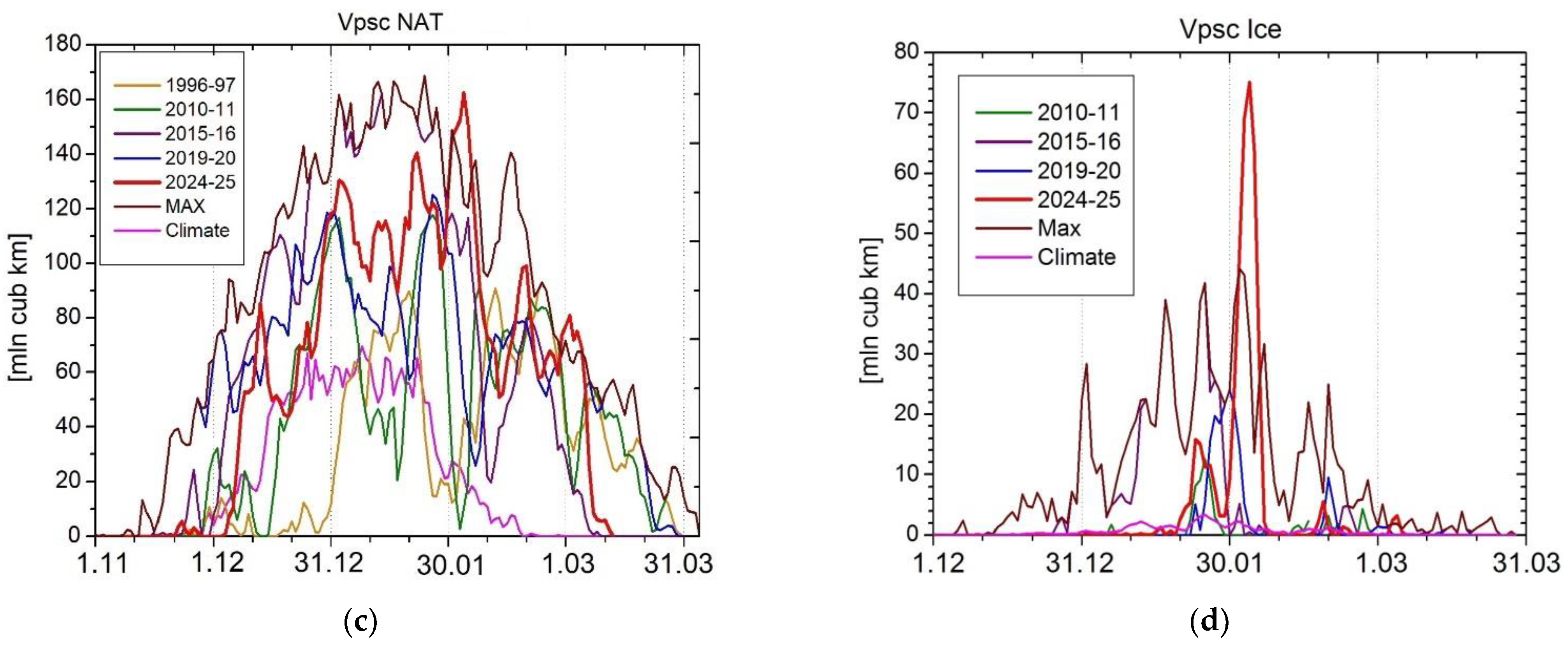

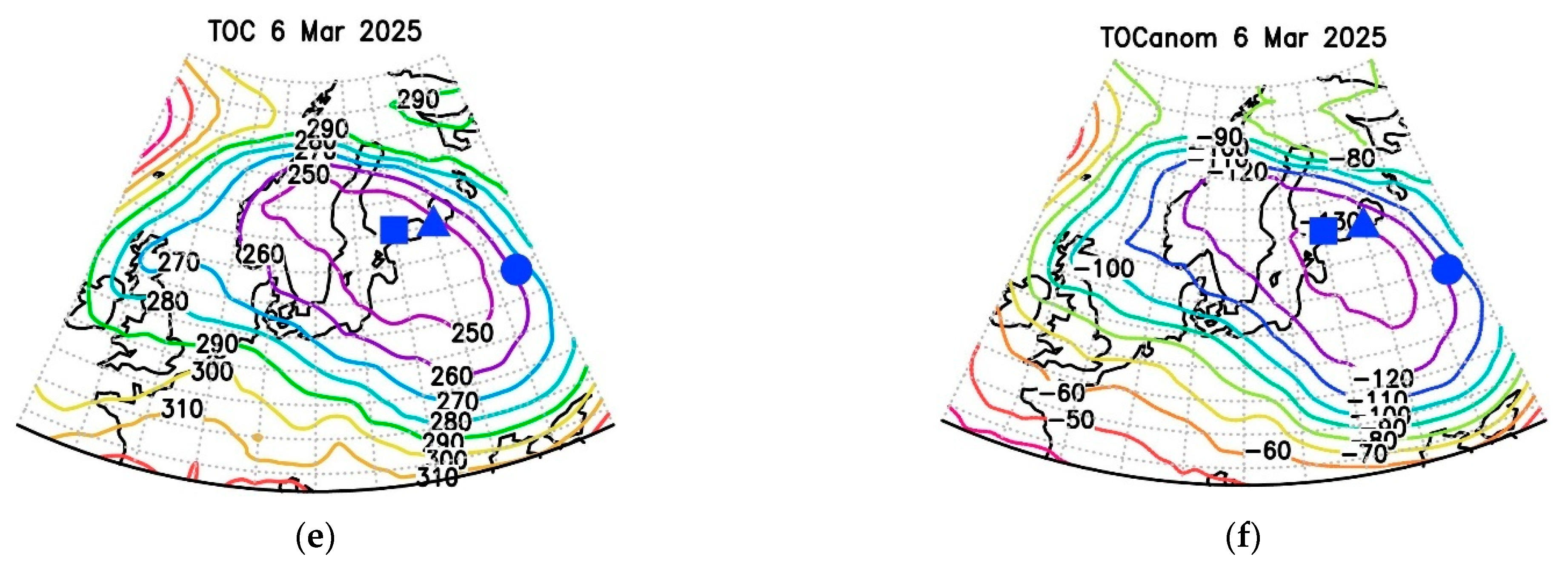
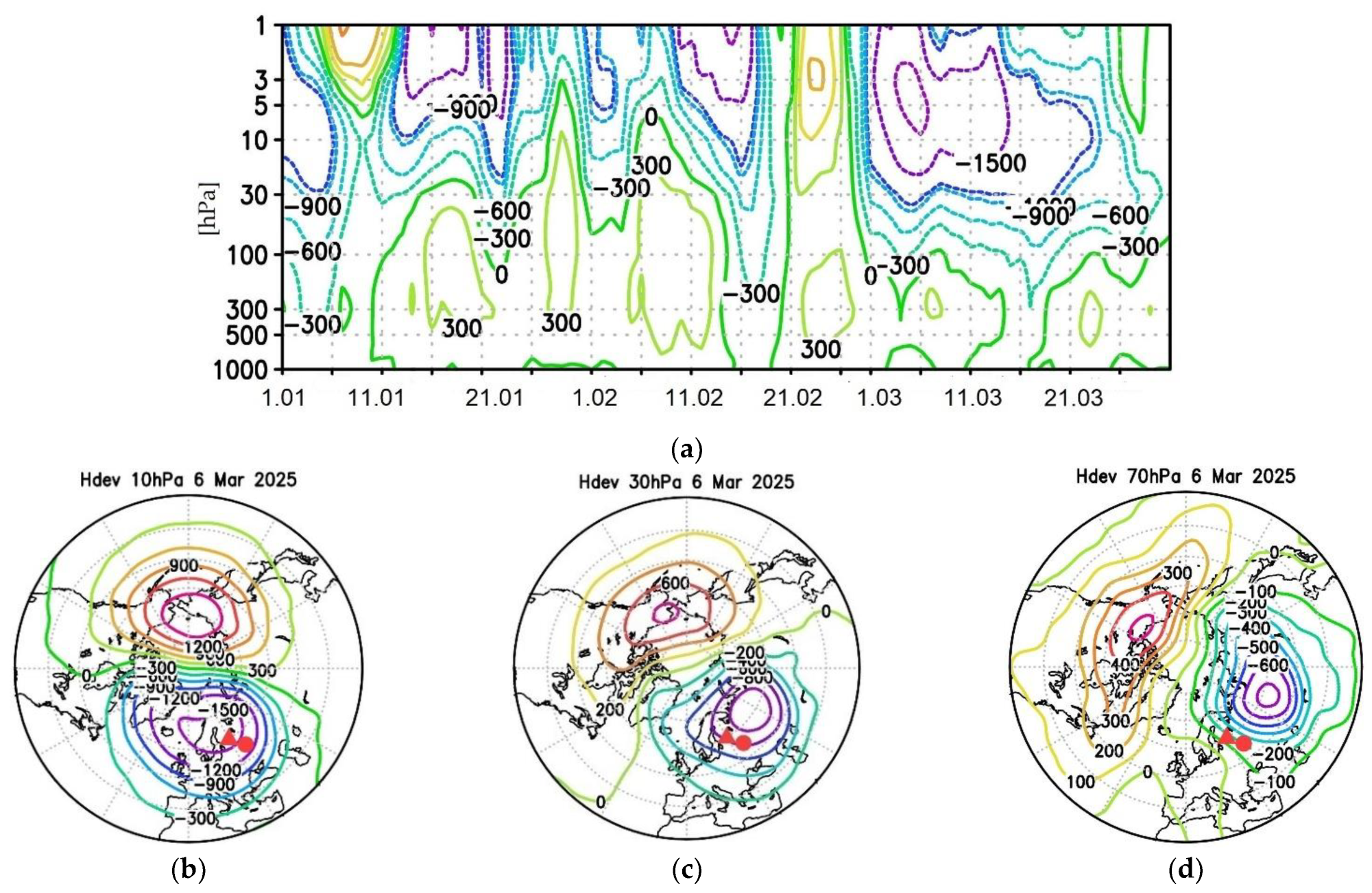




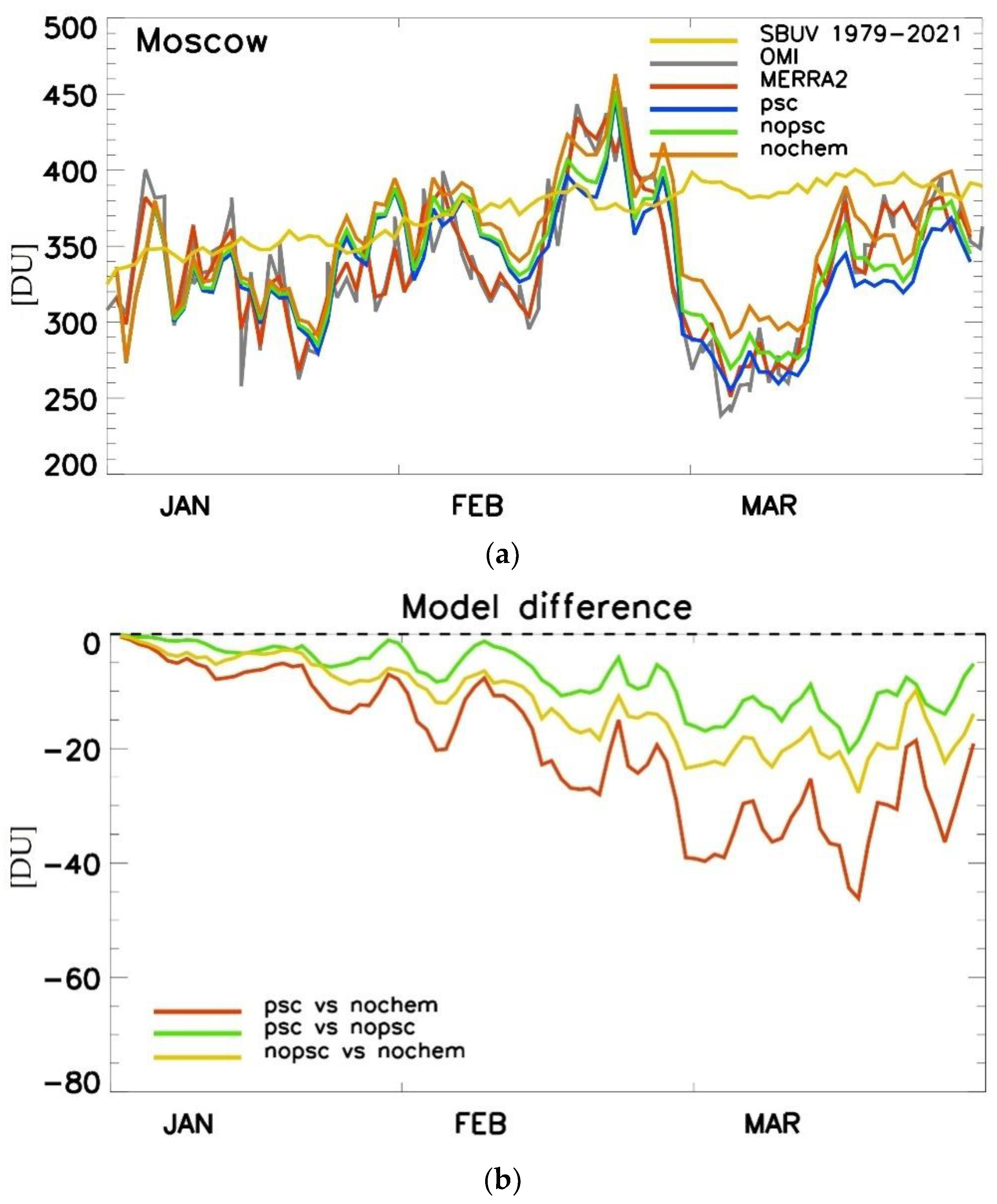


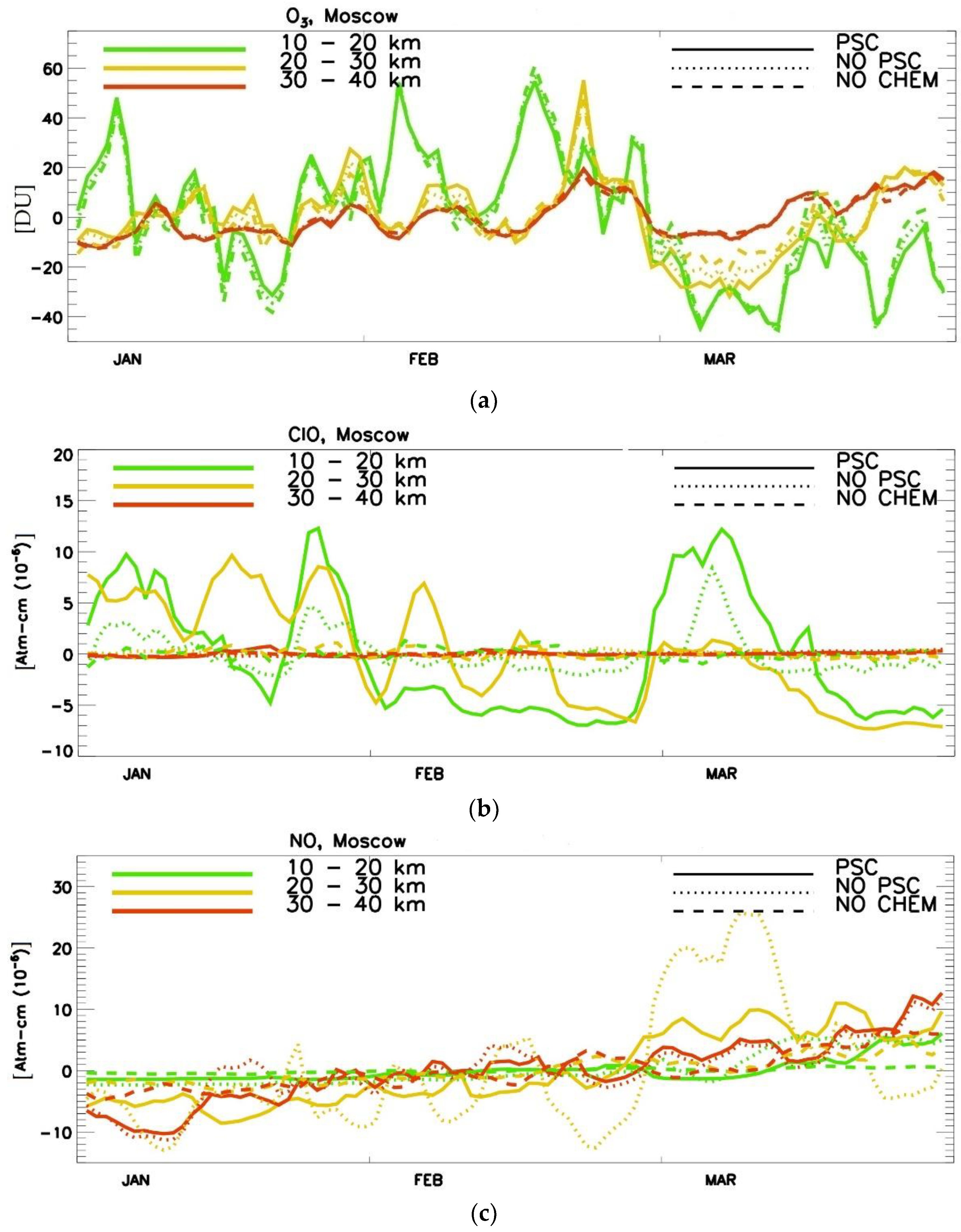
| Ozone Minimum 2025, DU | Ozone Standard, DU | Aerosol at 380 nm | UV Surface Albedo | UV Index at Minimum Ozone Clear/Cloudy | UV Index at Standard Ozone Clear /Cloudy | UV Index Difference Relative to the Standard Ozone Level, % | UV Resources Category at Minimum Ozone 2025 Clear/Cloudy | |
|---|---|---|---|---|---|---|---|---|
| Moscow (55.7° N 37.5° E) | ||||||||
| 20 Jan | 262.4 | 340.5 | 0.2 | 0.35 | 0.6/0.3 | 0.4/0.2 | 27% | UV deficiency/UV deficiency |
| 13 Feb | 295.4 | 369.3 | 0.2 | 0.37 | 1.1/0.6 | 0.9/0.5 | 24% | UV deficiency/UV deficiency |
| 5 March | 238.7 | 385.1 | 0.3 | 0.27 | 2.5/1.7 | 1.5/1.0 | 68% | UV optimum/UV optimum |
| St. Petersburg (60° N 30° E) | ||||||||
| 5 March | 221 | 382 | 0.3 | 0.27 | 1.6/1.0 | 1/0.6 | 60% | UV deficiency/UV deficiency |
| Helsinki (60° N 25° E) | ||||||||
| 5 March | 204 | 382 | 0.3 | 0.27 | 2.0/1.3 | 1/0.7 | 100% | UV optimum/UV optimum |
| Ozone Mini- mum 2025, DU | Ozone Standard, DU | Aerosol at 380 nm | UV Surface Albedo | UV Index at Minimum Ozone Clear/Cloudy | UV Index at Standard Ozone Clear/Cloudy | UV Index Difference Relative to Standard Ozone Level, % | UV Resources Category at Minimum Ozone 2025 Clear/Cloudy | |
|---|---|---|---|---|---|---|---|---|
| 6 April 2025 | ||||||||
| Moscow | 240 | 340.5 | 0.2 | 0.35 | 4.9/3.4 | 3.2/2.3 | 53% | Moderate UV excess/moderate UV excess |
| St. Peters- burg | 221 | 404 | 0.2 | 0.37 | 4.5/3.1 | 2.3/1.7 | 96% | Moderate UV excess/moderate UV excess |
| Helsinki | 204 | 385.1 | 0.3 | 0.27 | 4.8/3.5 | 2.3/1.7 | 110% | Moderate UV excess/moderate UV excess |
Disclaimer/Publisher’s Note: The statements, opinions and data contained in all publications are solely those of the individual author(s) and contributor(s) and not of MDPI and/or the editor(s). MDPI and/or the editor(s) disclaim responsibility for any injury to people or property resulting from any ideas, methods, instructions or products referred to in the content. |
© 2025 by the authors. Licensee MDPI, Basel, Switzerland. This article is an open access article distributed under the terms and conditions of the Creative Commons Attribution (CC BY) license (https://creativecommons.org/licenses/by/4.0/).
Share and Cite
Vargin, P.; Smyshlyaev, S.; Guryanov, V.; Chubarova, N.; Ionov, D.; Bankova, T.; Ivanova, N.; Solomatnikova, A. A Study of the Low-Ozone Episode over Scandinavia and Northwestern Russia in March 2025. Atmosphere 2025, 16, 1033. https://doi.org/10.3390/atmos16091033
Vargin P, Smyshlyaev S, Guryanov V, Chubarova N, Ionov D, Bankova T, Ivanova N, Solomatnikova A. A Study of the Low-Ozone Episode over Scandinavia and Northwestern Russia in March 2025. Atmosphere. 2025; 16(9):1033. https://doi.org/10.3390/atmos16091033
Chicago/Turabian StyleVargin, Pavel, Sergei Smyshlyaev, Vladimir Guryanov, Natalia Chubarova, Dmitry Ionov, Tatjana Bankova, Natalya Ivanova, and Anna Solomatnikova. 2025. "A Study of the Low-Ozone Episode over Scandinavia and Northwestern Russia in March 2025" Atmosphere 16, no. 9: 1033. https://doi.org/10.3390/atmos16091033
APA StyleVargin, P., Smyshlyaev, S., Guryanov, V., Chubarova, N., Ionov, D., Bankova, T., Ivanova, N., & Solomatnikova, A. (2025). A Study of the Low-Ozone Episode over Scandinavia and Northwestern Russia in March 2025. Atmosphere, 16(9), 1033. https://doi.org/10.3390/atmos16091033







